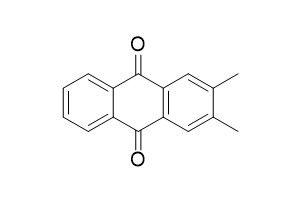2,3-Dimethylanthraquinone
2,3-Dimethylanthraquinone shows carcinogenicity.
Inquire / Order:
manager@chemfaces.com
Technical Inquiries:
service@chemfaces.com
Tel:
+86-27-84237783
Fax:
+86-27-84254680
Address:
1 Building, No. 83, CheCheng Rd., Wuhan Economic and Technological Development Zone, Wuhan, Hubei 430056, PRC
Providing storage is as stated on the product vial and the vial is kept tightly sealed, the product can be stored for up to
24 months(2-8C).
Wherever possible, you should prepare and use solutions on the same day. However, if you need to make up stock solutions in advance, we recommend that you store the solution as aliquots in tightly sealed vials at -20C. Generally, these will be useable for up to two weeks. Before use, and prior to opening the vial we recommend that you allow your product to equilibrate to room temperature for at least 1 hour.
Need more advice on solubility, usage and handling? Please email to: service@chemfaces.com
The packaging of the product may have turned upside down during transportation, resulting in the natural compounds adhering to the neck or cap of the vial. take the vial out of its packaging and gently shake to let the compounds fall to the bottom of the vial. for liquid products, centrifuge at 200-500 RPM to gather the liquid at the bottom of the vial. try to avoid loss or contamination during handling.
Front Chem.2023, 11:1245071.
J Ethnopharmacol.2017, 196:75-83
Food Chem X.2024, 24:101909.
Vietnam J. Chemistry2022, 60(2):211-222
Acta Agriculturae Scandinavica2015, 381-383
Bio-protocol2018, 9(14):e3301
Drug Des Devel Ther.2023, 17:2461-2479.
Agriculture2022, 12(12), 2173.
Phytomedicine.2022, 100:154036.
Molecules.2022, 27(5):1675
Related and Featured Products
Atmospheric Environment, 2013, 77(Oct.):974-982.
Analysis of atmospheric concentrations of quinones and polycyclic aromatic hydrocarbons in vapour and particulate phases.[Reference:
WebLink]
Polycyclic aromatic hydrocarbons (PAH) are often measured in studies of atmospheric chemistry or health effects of air pollution, due to their known human carcinogenicity. In recent years, PAH quinone derivatives have also become a focus of interest, primarily because they can contribute to oxidative stress.
METHODS AND RESULTS:
This work reports concentrations of 17 PAH and 15 quinones measured in air samples collected at a trafficked roadside. Data are presented for four compounds not previously reported in ambient air: 2-methyl-1,4-naphthoquinone, 2,6-di-tert-butyl-1,4-benzoquinone, methyl-1,4-benzoquinone and 2,3-Dimethylanthraquinone, and a large vapour phase component is measured, not analysed in most earlier studies. Analyses are reported also for SRM 1649a and 1649b, including many compounds (8 for SRM 1649a and 12 for SRM 1649b) for which concentrations have not previously been reported.
CONCLUSIONS:
This work assesses the vapour/particle phase distribution of PAHs and quinones in relation to their molecular weight, vapour pressure, polarity and Henry's Law constant, finding that both molecular weight and vapour pressure (which are correlated) are good predictors of the partitioning.



